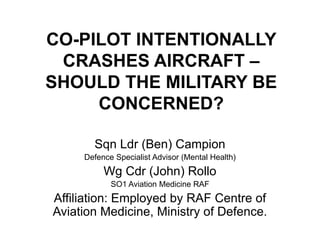Co-Pilot Intentionally Crashes Aircraft - Should the Military be Concerned? #ICASM2015
- 1. CO-PILOT INTENTIONALLY CRASHES AIRCRAFT ŌĆō SHOULD THE MILITARY BE CONCERNED? Sqn Ldr (Ben) Campion Defence Specialist Advisor (Mental Health) Wg Cdr (John) Rollo SO1 Aviation Medicine RAF Affiliation: Employed by RAF Centre of Aviation Medicine, Ministry of Defence.
- 2. Introduction
- 3. Methods: ŌĆó The authors reviewed the current policy both within the British Armed Forces and in the wider aviation industries, along with the literature released as a result of this tragedy. The military flying community is considered and the key differences with their civilian counterparts.
- 4. International Policy ŌĆó Already had ŌĆśrule of 2ŌĆÖ requirement: ŌĆō USA FAA ŌĆō CAA China ŌĆō Several European airlines ŌĆó Implemented new regulations in response: ŌĆō Aviation authorities in Australia, Canada, Germany, New Zealand and Philippines ŌĆō European Aviation Safety Agency Bulletin 2015-04
- 5. Military Policy ŌĆó GASO ??? ŌĆó Air Tanker ŌĆō Introduced ŌĆśrule of 2ŌĆÖ ŌĆó Hercules C130J SOP, Para 32, Page 12: Whenever the PNF visits the cargo compartment, the ALM should be present on the flight deck and on intercom. The selection of a PFD will help the ALM monitor the PF. ŌĆó Atlas A400 OM, Section 1.3, Page 11: Whenever the PM visits the cargo compartment, the LM should be present on the flight deck & on intercom. Displaying a PFD on the 3rd CM DU will help the LM monitor the PF. ŌĆó Globemaster C17 ???
- 6. Discussion: Factors that help to mitigate the military against such a disaster are discussed in the presentation: ŌĆō Open Cockpit. ŌĆō Squadron Ethos. ŌĆō Duty Holder. ŌĆō Medical Oversight. ŌĆō Mental Health Awareness Training. ŌĆō Aircrew Selection and Training. ŌĆō Psychological Testing ŌĆō Officer Training. ŌĆō Through Life Stress Management Policy.
- 9. Duty Holder.
- 11. MES Joint Medical Employment Standard
- 12. Mental Health Awareness Training.
- 14. Aircrew Selection and Training. http://www.youtube.com/watch?v=tR6Dyfp7Yf0
- 15. Psychological Testing ŌĆō Officer Training.
- 16. Through Life Stress Management Policy Stress Management Training is provided: ŌĆó During Initial Training ŌĆó During Promotion Courses ŌĆó Before, During & After Deployment ŌĆó On Retirement
- 17. Conclusion: ŌĆó These factors do make the ŌĆśriskŌĆÖ for the Military less than for commercial airlines. ŌĆó Fear of grounding from aircrew remains the greatest risk to flight safety, with some not asking for help until its too late. ŌĆó The MOD has done as much as it can to mitigate such risks, but it remains a salutary lesson that stigma towards mental health remains our key issue.
















